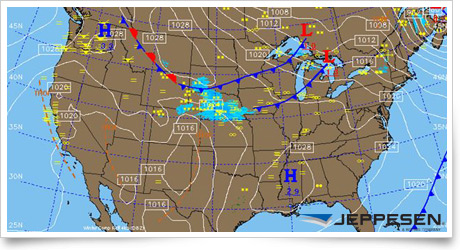| The following stories from the Dec. 16, 2011, edition of AOPA ePilot were provided to AOPA members who expressed an interest in the particular subject areas. Any AOPA member can receive information tailored to their areas of interest by updating their preferences online. |
training tips‘OTLK … VFR WND’ Checking weather after the soggy system soaked the scene, you are encouraged to see that visual conditions are returning. But the weather data contains details—captured in such places as the area forecast’s (FA) categorical outlook—urging caution. It says: “OTLK … VFR WND.” Why is that a key detail to consider? “The contraction ‘WND’ in the outlook signifies forecast winds of 20 knots or greater,” explains the section of AOPA’s Handbook for Pilots on weather briefing sources. Remember that the outlook period is a six-hour period that follows the FA’s 12-hour forecast period. The item tells you that strong winds will continue, even as overall weather improves. The latest hourly weather observation (METAR) also was a mixed message. It confirmed the presence of strong surface winds (29013G25KT) and offered the abbreviated remark PRESRR (pressure rising rapidly). The cause of the dynamic conditions faced by this pilot in northern New England is easy to pinpoint on the surface analysis chart shown above. The pilot would observe changing conditions as the low departs to the northeast, and a strong pressure gradient continues to exert influence over the area by generating strong, gradually diminishing winds. The pressure gradient appears as tightly spaced isobars—lines of constant pressure—on the chart. Locally, your terminal aerodrome forecast (TAF) predicts how the weather conditions are expected to manifest themselves in the short term. The pilot’s home airport had this forecast, predicting that it would not be until the forecast’s concluding period (FM090300) that the wild post-frontal weather would subside: 081256Z 0813/0912 32020G30KT 4SM -SN SCT005 OVC025 FM081300 31020G30KT P6SM -RASN BKN025 FM081500 30020G35KT P6SM SCT015 FM081700 20020G35KT P6SM SKC FM082300 27015G25KT P6SM SKC FM090300 23007KT P6SM SKC A lot of detail to absorb? With experience, you will eventually recognize that the basic trends make a familiar pattern that repeats itself regularly as fronts arrive and depart. That makes flight planning easier, and helps you understand how the myriad details of weather find their way into the big picture. training products‘Helicopter Maneuvers Manual’ from ASAThe Helicopter Maneuvers Manual, now available from ASA, is a step-by-step illustrated guide to performing all helicopter flight operations. Written by Ryan Dale, the guide includes full-color illustrations that are intended to help pilots visualize the concepts learned in flight training and incorporate the Practical Test Standards into each maneuver. The softcover version, with 104 pages, is priced at $14.95. An e-book version is available for $14.95. See the website for ordering information.
Note: Products listed have not been evaluated by ePilot editors unless otherwise noted. AOPA assumes no responsibility for products or services listed or for claims or actions by manufacturers or vendors. final exam
Question: As a certificated flight instructor applicant, what medical certificate would I be required to have?
Answer: There is no requirement for an applicant for an original issuance, renewal, or reinstatement of a flight instructor certificate to hold a medical. However, flight standards district office (FSDO) examiners as well as designated pilot examiners (DPEs) are discouraged, for liability reasons, from acting as pilot in command or as a required crewmember on practical tests. For that reason, many examiners may choose not to administer such a test. Check with your local FSDO and DPE to determine the possibilities. As a current CFI, there are certainly many opportunities to instruct without the requirement of a current medical. Read the article “Teaching without a medical.”
Got a question for our technical services staff? E-mail [email protected] or call the Pilot Information Center, 800/872-2672. Don’t forget the online archive of “Final Exam” questions and answers, searchable by keyword or topic. |
 A
A 

